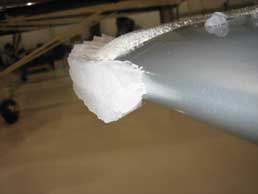A new airworthiness directive issued by the FAA bans most early Cessna twins from flight into known icing regardless of whether or not they are equipped with anti-icing gear.
It would appear that the FAA feels this to be necessary because too many pilots were ignoring a mandatory service bulletin that was issued by Cessna in 1997.
It was discovered that even a little ice on almost 7,000 of the twins could seriously affect the slow-speed handling.
This AD becomes effective April 7, 2014 and required the installation of a placard requiring an extra 15 knots on approach if there is an inadvertent encounter with icing.
This is the current list of the airplanes affected by this AD. (Cessna Twin)
It would appear that the FAA feels this to be necessary because too many pilots were ignoring a mandatory service bulletin that was issued by Cessna in 1997.
It was discovered that even a little ice on almost 7,000 of the twins could seriously affect the slow-speed handling.
This AD becomes effective April 7, 2014 and required the installation of a placard requiring an extra 15 knots on approach if there is an inadvertent encounter with icing.
This is the current list of the airplanes affected by this AD. (Cessna Twin)

No comments:
Post a Comment